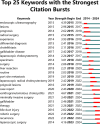Hotspots and scientometrics in gallbladder cancer surgery research: a bibliometric and visualization analysis (2014-2024)
- PMID: 40248210
- PMCID: PMC12003310
- DOI: 10.3389/fonc.2025.1522992
Hotspots and scientometrics in gallbladder cancer surgery research: a bibliometric and visualization analysis (2014-2024)
Abstract
Background: Gallbladder cancer (GBC) is the most common malignancy of the biliary tract, with significant geographical variations in incidence. The prognosis of GBC is generally poor due to its aggressive nature and late diagnosis. Surgical resection is the only curative treatment, but less than 10% of patients are eligible for radical surgery.
Methods: This study utilized bibliometric analysis and visualization tools to analyze research trends and hotspots in GBC surgery from 2014 to 2024. Data were collected from the Web of Science Core Collection using specific search terms related to GBC and surgical methods. The analysis was performed using tools such as CiteSpace, VOSviewer, and Microsoft Excel to identify key authors, institutions, countries, and research themes.
Results: A total of 479 publications were analyzed, showing a significant increase in research output and citation frequency over the past decade. China and the United States were the leading contributors to GBC surgery research. The analysis revealed six main research clusters, focusing on early diagnosis, surgical techniques, postoperative management, and the application of advanced technologies such as laparoscopic and robotic surgery.
Conclusions: The study highlights the evolution of research priorities in GBC surgery, with a shift towards minimally invasive techniques and comprehensive postoperative management. Future research should emphasize international collaboration and the exploration of emerging technologies to improve patient outcomes.
Keywords: bibliometric analysis; gallbladder cancer; laparoscopic surgery; postoperative management; surgery.
Copyright © 2025 Chen, Bin, Zhang, Li, Chen and Ge.
Conflict of interest statement
The authors declare that the research was conducted in the absence of any commercial or financial relationships that could be construed as a potential conflict of interest.
Figures







Similar articles
-
Publication Trends of Research on Gallbladder Cancer During 2001-2021: A 20-Year Bibliometric Analysis.Front Oncol. 2022 Jul 11;12:932797. doi: 10.3389/fonc.2022.932797. eCollection 2022. Front Oncol. 2022. PMID: 35898881 Free PMC article.
-
Bibliometric and visualized analysis of research relating to minimally invasive spine surgery reported over the period 2000-2022.Digit Health. 2023 May 4;9:20552076231173562. doi: 10.1177/20552076231173562. eCollection 2023 Jan-Dec. Digit Health. 2023. PMID: 37163171 Free PMC article.
-
Research hotspots and trends of mesenchymal stem cell-derived extracellular vesicles for drug delivery: a bibliometric and visualization analysis from 2013 to 2023.Front Cell Dev Biol. 2024 Oct 30;12:1412363. doi: 10.3389/fcell.2024.1412363. eCollection 2024. Front Cell Dev Biol. 2024. PMID: 39539963 Free PMC article.
-
Bibliometric study of immunotherapy for hepatocellular carcinoma.Front Immunol. 2023 Aug 4;14:1210802. doi: 10.3389/fimmu.2023.1210802. eCollection 2023. Front Immunol. 2023. PMID: 37600802 Free PMC article. Review.
-
Bibliometric analysis of the research hotspots and trends of circular RNAs.Heliyon. 2024 May 17;10(10):e31478. doi: 10.1016/j.heliyon.2024.e31478. eCollection 2024 May 30. Heliyon. 2024. PMID: 38818139 Free PMC article. Review.
References
LinkOut - more resources
Full Text Sources
Miscellaneous

